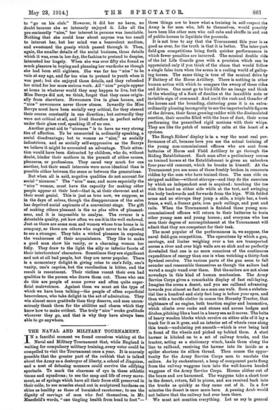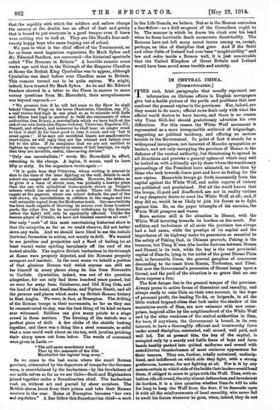THE NAVAL AND MILITARY TOURNAMENT.
IN a fanciful moment we found ourselves wishing at the Naval and Military Tournament that, while England is waiting for compulsory military training, every voter could be compelled to visit the Tournament once a year It is scarcely possible that the greater part of the rubbish that is talked about the Army as a destroyer of liberty, a school of Jingoism, and a nest of debasing manners could survive the edifying spectacle. To mark the clearness of eye in these athletic teams and squadrons; to see the snap and life of every move- ment, as of springs which have all their force still preserved in their coils; to see muscles stand out in sculptured hardness on skins as healthy as those of burnished racehorses; to see the dignity of carriage of men who feel themselves, in Mr. Masefield's words, "one tingling health from head to foot"—
these things are to know what a training in self-respect the Army is for men who, left to themselves, would possibly have been like other men who call cabs and shuffle in and out of public-houses to liquidate the proceeds.
It is not true to say that the Tournament this year is as good as ever, for the truth is that it is better. The inter-port field-gun competitions bring forth quicker performances in which fewer penalties are incurred. The musical double ride of the 1st Life Guards goes with a precision which can be appreciated only if you think of the chaos that would follow a single false turn when the arena is a reeling world of gallop. ing horses. The same thing is true of the musical drive by F Battery of the Horse Artillery. There is nothing in other human action with which to compare the swoop of these rides and drives. One must go to bird-life for an image and think of the wheeling of a flock of dunlins at the inaudible note or invisible sign of command. And amid the rush and thunder of the horses and the bounding, clattering guns it is an extra- ordinarily pleasing incongruity to see the imperturbable figures of the drivers, their faces growing redder with the dissimulated exertion, their mouths filled with the haze of duet, their arms performing the prescribed rigid motions with their whips. They are like the patch of unearthly calm at the heart of ■ cyclone.
The Rough Riders' display is in a way the most real per- formance of all, because here you see the actual training of the young non-commissioned officers who are sent from batteries of Horse and Field Artillery to go through the Riding Establishment. Each man after a preliminary course on trained horses at the Establishment is given an unbroken four-year-old remount, which he breaks in himself. At the Tournament you see some of these freshly broken in remounts ridden by the men who have trained them. The men ride on stripped saddles—without stirrups—and they do the exercises by which an independent seat is acquired : touching the toe with the hand on either side while at the trot, and swinging the body backwards and forwards from the hips. With folded arms and no stirrups they jump a stile, a triple bar, a bush fence, a wall, a Sussex gate, iron park railings, and post and rails. When the Tournament is finished these young non- commissioned officers will return to their batteries to train other young men and young horses ; and everyone who has seen their degree of accomplishment at the Tournament will admit that they are competent for their task.
The most popular of the performances is, we suppose, the naval field-gun competition. The operations by which a gun, carriage, and limber weighing over a ton are transported across a river and over high walls are so slick and so perfectly dovetailed that one is no more conscious of the continuous expenditure of energy than one is when watching a thirty-foot flywheel revolve. The various parts of the gun seem to fall asunder and reassemble themselves as though the sailors had waved a magic wand over them. But the sailors are not alone nowadays in this kind of human mechanism. The Army Service Corps gives a remarkable display of fast rail-laying. Imagine the arena a desert, and you see railhead advancing towards you almost as fast as a man can walk. Soon a substan- tial line a hundred and sixty feet long is before your eyes, and then with a terrific clatter in comes the Hornsby Tractor, that nightmare of an engine, both traction engine and locomotive, which climbs over rocks and stones and across hedges and ditches, pitching like a boat in a heavy sea as it moves. The belts of heavy wooden blocks which revolve on either side of it lay a track for it as it goes, and an interior set of wheels runs along this track—undulating yet smooth—which is ever being laid in front of the wheels and picked up behind them. A steel hawser is hitched on to a set of railway trucks, and the tractor, acting as a stationary winch, hauls them along the line to railhead, receiving the hawser into its inside as a spider shortens its silken thread. Then comes the oppor- tunity for the Army Service Corps men to emulate the sailors. As by enchantment, a heap of component parts flung from the railway waggons turn into the well-known hooded waggons of the Army Service Corps. Horses slither out of the boxes and are harnessed. The waggons take a short tour in the desert, return, fall to pieces, and are received back into the trucks as quickly as they came out of it. In a few minutes the desert is once more bare. A passing Arab would not believe that the railway had ever been there.
We must not mention everything. Let us say in general
that the rapidity with which the soldiers and sailors change the scenery at the double has an effect of dash and gaiety that is bound to put everyone in a good temper even if there were nothing else to look at. They are like Hood's four-and- twenty happy boys who came leaping out of school.
We pass to what is the chief effort of the Tournament, so far as those most ingenious organizers, Sir Mark Sykes and Mr. Edmund Sanders, are concerned—the historical spectacle called "The Romans in Britain." A horrible rumour some weeks ago said that in the Triumph of the Emperor Claudius at Rome the British King Cymbeline was to appear, although Cymbeline was dead before ever Claudius came to Britain. This rumour turned out to be quite untrue. We might, indeed, have trusted Sir Mark Sykes. As he and Mr. Edward Sanders showed in a letter to the Times in answer to some uneasy questions from Mr. Haverfield, their scrupulousness was beyond reproach We promise him if he will but oome to the Show he shall behold Crassus Frugi on his horse (Suetonites, Claudius, cap. 17), a wall twelve feet high in one place so as to coincide with Bede and fifteen feet high in another to fulfil the statements of other authorities (see Bruce), a carroballista which we have built at the risk of our own limbs (see Payne-Gall wey, Vitrnvins, Napoleon III., Perault, and others), and moreover he shall hear an onager creak so that it shall do his heart good to hear it creak, and cry 'Let it creak again If he says our sacrificial beasts are anachronistic short-horns, we will reply they are the whitest and fattest ever led to the altar. It he complains that we are not entitled to tighten up our onager's sinews by means of ball bearings, we reply that they are invisible, useful, time-saving devices."
"Only one earroballista!" wrote Mr. Haverfield in effect, returning to the charge. A legion, it seems, used to have fifty or sixty. So the organizers wrote again :— "It is quite true that Vitnivine, whose writing is nearest in date to the time of the later fighting on the wall, details to each cohort one onager and one carroballista. However, the latter, as he gives it a team of eleven men, was probably a heavier piece than the one with cylindrical tones-guards shown on Trojan's column which has served us as a model. There will therefore appear at the pageant, where one cohort defends the part of the wall shown, six carroballistae in addition to the onager and two wall catapults copied from the Moderates tomb. One carroballista has been made capable of throwing its arrows over three hundred yards, the other five (to be unwisely withdrawn by the Romans before the fight) will only be apparently efficient Unlike the famous player of Othello, we have not blacked ourselves all over."
Our only " crab" of this most entertaining historical show is that the catapults, so far as we could observe, did not batter down any walls. And we should have liked to see the tested° (tortoise) formation in action, not merely in drill. We wanted to see javelins and projectiles and a flood of boiling (or at least warm) water spirting harmlessly off the roof of the locked shields. The captive British barbarians in the triumph at Rome were properly dejected, and the Romans properly arrogant and insolent. In the next scene we beheld a portion of that glorious Roman wall which anyone can still see for himself in many places along its line from Newcastle to Carlisle. Cymbeline, indeed, was out of the question altogether, for not only bad three hundred years passed, but we were far away from Colchester, and Old King Cole, and the land of the Ieeni, and Boadicea, and Tiptree Heath, and all the persons and places which make up British-Roman history in East Anglia. We were, in fact, at Brampton. The drilling of the Roman troops in their movements, so far as they can be reconstructed to-day, was the best thing of its kind we have ever witnessed. Soldiers can give many points to a stage crowd in these matters. The forming of the fesincle was a perfect piece of drill. A few clicks of the shields locking together, and there was a thing like a steel casemate, so solid that a man could walk about on the top, with javelins pricking their sharp noses out from below. The words of command were given in Latin
The self-same mandatory word That by the cataracts of the Nile Marshalled the legions' long array."
So we come to the last scene where the small Roman garrison, attenuated by the departure of troops for the German wars, is overwhelmed by the barbarians—by the forefathers of our noble selves so far as we are Celta—Scoti and Highlanders joined together under a Scandinavian chief. The barbarians rush on without art and prevail by sheer numbers. The British slaves burst from their prison and take their Roman masters in the rear. Borne at Brampton becomes "her own sad sepulchre." A fine fellow this Scandinavian chief—a cook in the Life Guards, we believe. But so is the Roman centurion a fine fellow—as a drill sergeant of the Grenadiers ought to be. The manner in which he draws his cloak over his bead when he faces inevitable death surmounts theatricality. The Romans have not left many moral traces among us, except, perhaps, an idea of discipline that grew. And if the Scoti and other Celts of Ireland had ever been" taught civility" and law and order inside a Roman wall, it is just conceivable that the United Kingdom of Great Britain and Ireland would have been saved some trouble and anxiety.















































 Previous page
Previous page